Decoding the Derriere, or, have you read the word “crotch” enough today?
Here’s something you may not know – Google scours the internet reading key words on websites to decide how important and relevant that website is in search results. If you have too many no-no words Google might confuse your site with say, a p*rn site. So if you notice that I use a lot of euphemisms for your backside – it’s not that I can’t bring myself to say certain words – it’s just that I don’t want to upset the Google gods!
Ok! Back to our regularly scheduled program.
Ever since Colette launched their Clover pants pattern it seems that the sewing blogosphere has been gaga over making pants with an equal number of successes and failures along the way. I’m no exception although I feel like I’ve had more failures than not.
Every body is different but while bodices and skirts seem to be relatively simple to fit, pants are tricky. And the main struggles revolve around the crotch line – depth, inseam, length, curve, etc.
I’ve made three pairs of shorts and three pairs of pants (and one pants muslin) in my sewing career with varying results. I’ve noticed that the looser the pants/shorts the easier they are to fit and the shape of the crotch line is a big deal.
I’ve taken it upon myself to research and compare a bunch of pants patterns with my own RTW pants and the differences, to me, are mind blowing! Maybe this can be eye opening to others facing a similar problem.
Here are a bunch of patterns all from different companies. From left to right – Butterick 5682, Simplicity 3850 (which I showed you yesterday), Kiwk Sew 3854 (these shorts), New Look 6100, McCall’s 6405, and Colette Clovers. Click on the pics for a bigger view.
Now here are two pairs of my fave skinny jeans and the last is a pair of wide leg, mid rise jeans. I traced the back crotch line. These are Gap and some other random company.
And now here are all the crotch lines together. The black line is a composite of my jeans (they were nearly identical).
See how different each one is? No wonder it is hard to find a good fitting pants pattern!
And a bigger problem for me – some of these patterns dip too far back to even let out the back seam for a good fit. The J shape in both the Colette and Butterick patterns are way too deep for my behind. Now I know that if I sew up the Clovers as is I’ll have a big blob of extra fabric under my bum. That also explains why I had some major backside problems with the Butterick pattern before.
You have to remember that some of these patterns have back darts and others have yokes so that changes the waist lines. The curve at the center back waist on the Simplicity pants is so sharp because the only shaping comes in the side and back seams.
When you take into consideration the darts in the New Look pattern that crotch line will look a lot more like my RTW jeans. Just by looking the Kwik Sew crotch line seems to match up the best. To make a good fitting pair of skinny jeans I think the Simplicity pants give me the most room to work with in the derriere.
Looking at this I feel like I suddenly understand my problems and what to do to fix them. MIND. BLOWN.
Now I know why the Kwik Sew and Simplicity shorts fit much better than anything else I have tried and hopefully I can save myself some headaches next time!
***Have you tried this comparison? Are you one of the lucky ones to find a good pants pattern that you guard with your life?

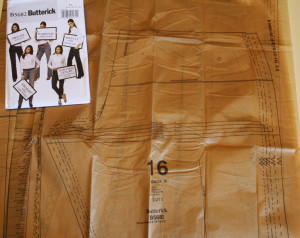

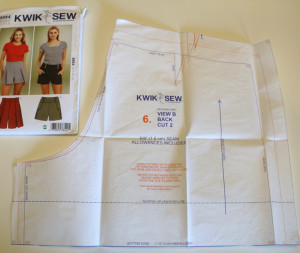
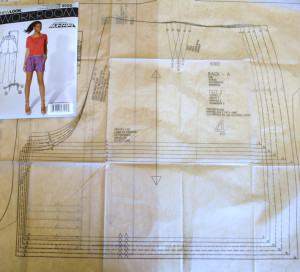
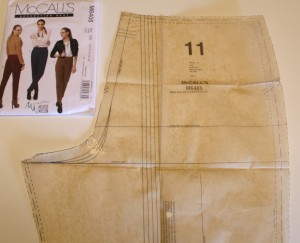
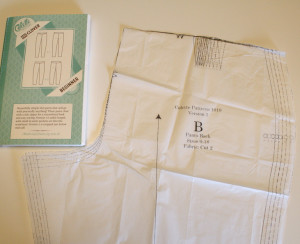
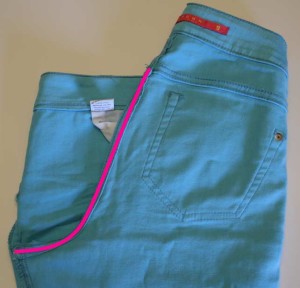
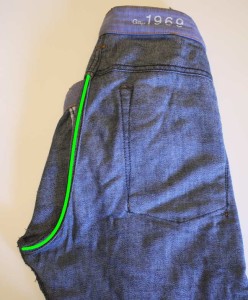
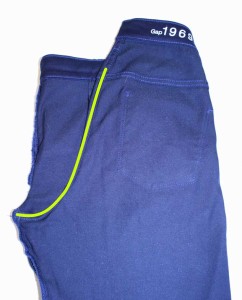
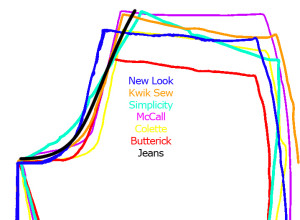
This is really interesting. Thanks for putting all of the pants patterns together to show the differences.
I’m confused though as to what the differences in the crotch curvature and slope of the waist lines do for fit. This would be a really interesting topic to research. Hmmm, I see a library trip in my future 🙂
you’re welcome! thanks for commenting! it’s hard to imagine how that 2D pattern piece curves to fit your bum in 3D. i recommend checking out Pants for Real People. lots of great fitting techniques. but i think a pattern drafting book might even help more with those “pattern theory” kind of ideas revolving around what shape or angle equals a good fit on the body.
I’ve had bad luck with all of those pattern companies, too.
Two suggestions: there is a new class on craftsy.com by Kenneth King called “Jean-ius” and he teaches how to copy your favorite jeans. Even after the muslin is sewn, minor fitting adjustments are necessary, and it is really helpful to observe.
My other suggestion is Style Arc Patterns. I have been very happy with the fit – it seems similar to RTW.
good luck!!
i’m definitely going to try out that jeans class on craftsy the next time it goes on sale. i’ve heard of style arc but i’ve never bought one of their patterns (shipping from Aus to texas is pretty steep) but i may give them a try. thanks for the tip!
Thank you for a most informative post. You’re right bodices are skirts are fairly straight forward to trouble shoot but pants is whole different ball game.
When I first started sewing, not too long ago, I tried Burda’s Ellen pants. The first was a total flop, I couldn’t even zip up that damn thing. The next one was better but I felt I needed to always pull it up!
So finally, I learnt to draft my own pants block from eSewing Workshop and am now enrolled in Kenneth D. King’s online lessons on Craftsy to learn more about the construction of a pair of pants / jeans.
i’m really interested in King’s jeans class. i’d also like to draft my own pant/shorts at some point. always searching for that perfect fit!!
Dixie what a fabulous idea! And I’m a total sucker for a graph. you are going to totally nail pants, I do declare!
haha, thanks julia!!
Pretty fascinating to see how different they all are. I like the way you think. Those Kwik Sew shorts you made are adorable, by the way.
I don’t know my crotch shape (errr… sounds weird) but I like the look of the Simplicity pants so maybe I’ll jump into pants-making with that pattern. Hopefully I’ll have your same good luck with them.
thanks! i really like that simplicity pattern. it was my first introduction to shorts and to fly front zips. plus i think shorts are a fun intro to pants because you don’t have to fit the legs. one less thing to fuss over.
Very interesting! I’m definitely going to re-visit this post when I try pants. Thanks for sharing 🙂
Fascinating! Not that I’ve dared sew trousers yet but I’ll be bearing this in mind when I do. What a good idea to compare with your RTW jeans.
I’m slapping my head repeatedly. I’d never thought to do this comparison. It makes our fitting trials and tribulations so much more explicable. Thanks so much for doing the work on this and sharing your findings.
i had the same “head slapping” experience, too. and thank you for reading!
This was really informative. I am going to take out my patterns and look at them more closely.
What a very interesting comparison! I’ve only ever made pants once, and made and attempt to self-draft them, but they were rather loose, so it worked out alright. I’ll definitely have to check the shape of my fitting RTW pants now, before I attempt my next pair!
thanks! i agree, the looser the pants the more you can get away with in terms of exacting fit, i think.
this is truly enlightening!! my big problem is this … i don’t own a pair of nice fitting pants to compare to!
awww, that’s too bad – although i’m sure that problem is why some women want to try making their own pants in the first place. maybe you could try self drafting based on your own personal measurements? i’ve heard of tutorials out there online but I’ve never used one.
Love this post! all those colored lines… my head is swimming! I did do this comparison recently with the recent pair of trousers I made, and found that they were a match for my favorite jeans–just a lucky fluke.
wow, that is lucky!
When I took a trouser class that revolved around getting an excellent fit, we measured the length of our crotch curve and compared it to the length of the crotch curve on the pattern, but we didn’t necessarily examine the shape of it.
Trousers are much less fitted than pants, so maybe that’s how we got away with it, but thanks for writing this post.
I’m going to keep this question in mind when I sew my next pants.
Great post! I compared the Clover to the so-close-to-perfect jeans I’d previously made, and my RTW jeans, but I didn’t let it stop me. Wise woman, you 🙂 I’ve already decided my next pair will barely be able to be called Clover at all… more like frankenclover, a la the Jean-ius class on Craftsy.
Sooo interesting but I’ll need to read really closely again since I’m Swedish. But thanks, this’ll help me a lot once I understand it completely ;-).
One way to cheat the fit adjustments a bit is to cut a different size for the front and back. For example I have a full derriere so I often cut a medium front and a large back. Obviously you want the side and inseam seams to match up still so I’ll typically extend the medium side seam to the large width and do whatever seems to make the most sense for the back center and inseam (sometimes tricky!) with the focus on getting a longer crotch length and keeping the final inseam length the same.
Hi
If I am not making my own pattern I always use Burda patterns mainly because of the crotch line. My rule of thumb for a crotch if it looks like I could sit in it it’s OK.